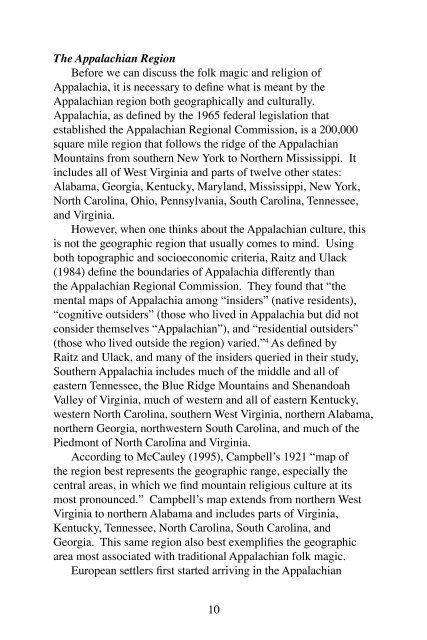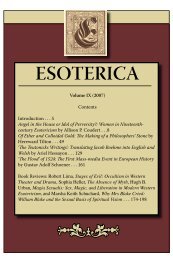Download - Esoterica - Michigan State University
Download - Esoterica - Michigan State University
Download - Esoterica - Michigan State University
Create successful ePaper yourself
Turn your PDF publications into a flip-book with our unique Google optimized e-Paper software.
The Appalachian Region<br />
Before we can discuss the folk magic and religion of<br />
Appalachia, it is necessary to define what is meant by the<br />
Appalachian region both geographically and culturally.<br />
Appalachia, as defined by the 1965 federal legislation that<br />
established the Appalachian Regional Commission, is a 200,000<br />
square mile region that follows the ridge of the Appalachian<br />
Mountains from southern New York to Northern Mississippi. It<br />
includes all of West Virginia and parts of twelve other states:<br />
Alabama, Georgia, Kentucky, Maryland, Mississippi, New York,<br />
North Carolina, Ohio, Pennsylvania, South Carolina, Tennessee,<br />
and Virginia.<br />
However, when one thinks about the Appalachian culture, this<br />
is not the geographic region that usually comes to mind. Using<br />
both topographic and socioeconomic criteria, Raitz and Ulack<br />
(1984) define the boundaries of Appalachia differently than<br />
the Appalachian Regional Commission. They found that “the<br />
mental maps of Appalachia among “insiders” (native residents),<br />
“cognitive outsiders” (those who lived in Appalachia but did not<br />
consider themselves “Appalachian”), and “residential outsiders”<br />
(those who lived outside the region) varied.” 4 As defined by<br />
Raitz and Ulack, and many of the insiders queried in their study,<br />
Southern Appalachia includes much of the middle and all of<br />
eastern Tennessee, the Blue Ridge Mountains and Shenandoah<br />
Valley of Virginia, much of western and all of eastern Kentucky,<br />
western North Carolina, southern West Virginia, northern Alabama,<br />
northern Georgia, northwestern South Carolina, and much of the<br />
Piedmont of North Carolina and Virginia.<br />
According to McCauley (1995), Campbell’s 1921 “map of<br />
the region best represents the geographic range, especially the<br />
central areas, in which we find mountain religious culture at its<br />
most pronounced.” Campbell’s map extends from northern West<br />
Virginia to northern Alabama and includes parts of Virginia,<br />
Kentucky, Tennessee, North Carolina, South Carolina, and<br />
Georgia. This same region also best exemplifies the geographic<br />
area most associated with traditional Appalachian folk magic.<br />
European settlers first started arriving in the Appalachian<br />
10



